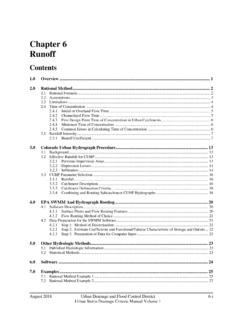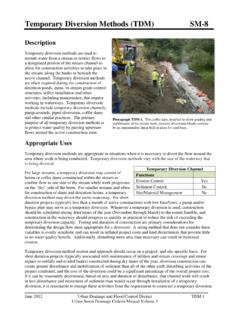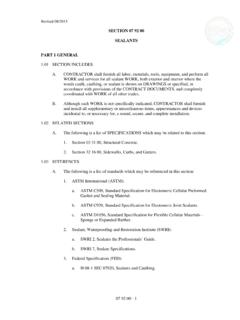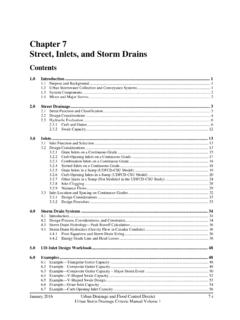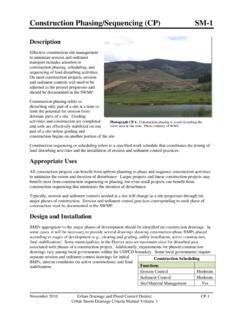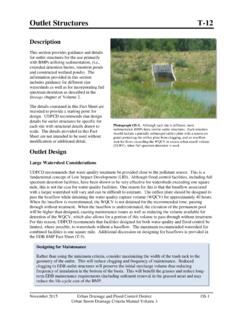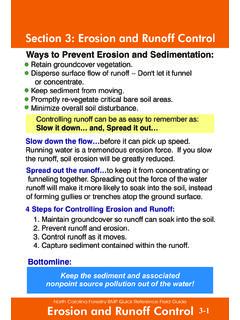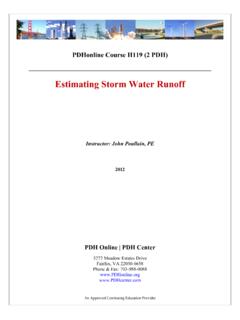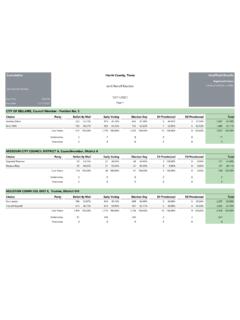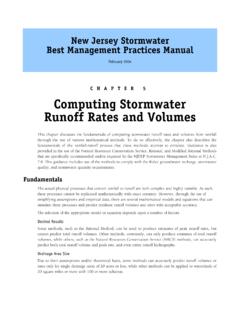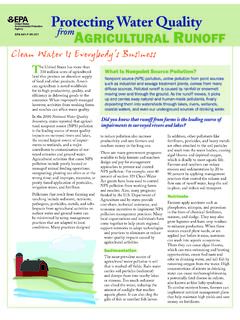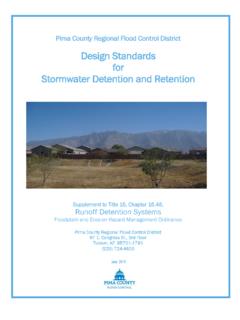Transcription of Chapter 6 Runoff - UDFCD
1 August 2018 Urban Drainage and Flood Control District 6- i Urban Storm Drainage Criteria Manual Volume 1 Chapter 6 Runoff Contents Overview .. 1 Rational Method .. 2 Rational Formula .. 2 Assumptions .. 3 Limitations .. 4 Time of Concentration .. 4 Initial or Overland Flow Time .. 5 Channelized Flow Time .. 5 First Design Point Time of Concentration in Urban Catchments .. 6 Minimum Time of Concentration .. 6 Common Errors in Calculating Time of Concentration .. 6 Rainfall Intensity .. 7 Runoff Coefficient .. 7 Colorado Urban Hydrograph Procedure .. 13 Background .. 13 Effective Rainfall for CUHP .. 13 Pervious-Impervious Areas .. 13 Depression Losses.
2 14 Infiltration .. 14 CUHP Parameter Selection .. 16 Rainfall .. 16 Catchment Description .. 16 Catchment Delineation Criteria .. 18 Combining and Routing Subcatchment CUHP Hydrographs .. 18 EPA SWMM And Hydrograph Routing .. 20 Software Description .. 20 Surface Flows and Flow Routing Features .. 20 Flow Routing Method of Choice .. 21 Data Preparation for the SWMM Software .. 21 Step 1: Method of Discretization .. 21 Step 2: Estimate Coefficients and Functional/Tabular Characteristic of Storage and Outlets .. 22 Step 3: Preparation of Data for Computer Input .. 23 Other Hydrologic Methods .. 23 Published Hydrologic Information .. 23 Statistical Methods.
3 23 Software .. 24 Examples .. 25 Rational Method Example 1 .. 25 Rational Method Example 2 .. 27 6- ii Urban Drainage and Flood Control District August 2018 Urban Storm Drainage Criteria Manual Volume 1 References .. 29 Tables Table 6-1. Applicability of hydrologic methods .. 2 Table 6-2. NRCS Conveyance factors, 5 Table 6-3. Recommended percentage imperviousness values .. 8 Table 6-4. Runoff coefficient equations based on NRCS soil group and storm return period .. 9 Table 6-5. Runoff coefficients, c .. 10 Table 6-5. Runoff coefficients, c (continued) .. 11 Table 6-6. Typical depression losses for various land covers .. 14 Table 6-7. Recommended Horton s equation parameters.
4 15 Figures Figure 6-1. Runoff coefficient vs. watershed imperviousness NRCS HSG A .. 11 Figure 6-2. Runoff coefficient vs. watershed imperviousness NRCS HSG B .. 12 Figure 6-3. Runoff coefficient vs. watershed imperviousness NRCS HSG C and D .. 12 Figure 6-4. Slope correction for streams and vegetated channels .. 19 August 2018 Urban Drainage and Flood Control District 6- 1 Urban Storm Drainage Criteria Manual Volume 1 Overview The importance of accurate Runoff quantification cannot be overstated. Estimates of peak rate of Runoff , Runoff volume, and the time distribution of flow provide the basis for all planning, design, and construction of drainage facilities.
5 Erroneous hydrology results in infrastructure that is either undersized, oversized, or out of hydraulic balance. At the same time it is important to understand that the result of the Runoff analysis is an approximation. Thus, the intent of this Chapter is to provide a reasonably dependable and consistent method of approximating the characteristics of urban Runoff for areas of Colorado and the United States having similar meteorology and hydrology to what is found within the Urban Drainage and Flood Control District ( UDFCD ) region. Five methods of hydrologic analysis are described in the Urban Storm Drainage Criteria Manual (USDCM): 1. The Rational Method, 2. The Colorado Urban Hydrograph Procedure (CUHP) for generating hydrographs from watersheds, 3.
6 The EPA s Storm Water Management Model (SWMM), mostly for combining and routing the hydrographs generated using CUHP, 4. Use of published Runoff information, and 5. Statistical analyses. Most of this Chapter focuses on the Rational Method and CUHP in combination with SWMM routing. Table 6- 1 provides a summary of applicability for both methods. The Rational Method can be used to analyze the design storm Runoff from urban catchments that are not complex and that are generally 90 acres or less and when only the peak flow rate is needed ( , storm drain sizing). Calculations for the Rational Method can be carried out by hand or using the UD-Rational Excel workbook available at Since 1969, CUHP has been used extensively in this region.
7 It has been calibrated for the UDFCD region using data collected for a variety of watershed conditions. The vast majority of major drainage systems within UDFCD are designed based upon the hydrology calculated using CUHP and a customized version of the EPA s Stormwater Management Model (SWMM), Runoff block, named the Urban Drainage Stormwater Model (UDSWM). In 2005, UDFCD began using and recommending the EPA s SWMM Version 5 and upgraded the CUHP software to be compatible with that model. CUHP and SWMM should be used for larger catchments or when a hydrograph of the storm event is needed. There have been hydrologic studies carried out for a majority of the major drainage systems within UDFCD and published flow data are available for most of these systems.
8 Photograph 6-1. Devastating flooding from Gregory Canyon Creek in Boulder in September 2013 emphasizes the importance of accurate flood flow projections. 6- 2 Urban Drainage and Flood Control District August 2018 Urban Storm Drainage Criteria Manual Volume 1 Statistical analyses may be used in certain situations outside the UDFCD boundary. The use of this approach requires the availability of acceptable, appropriate, and adequate data. Table 6-1. Applicability of hydrologic methods Watershed Size (acres) Is the Rational Method Applicable? Is CUHP Applicable? 0 to 90 Yes Yes 90 to 160 No Yes 160 to 3,000 No Yes1 Greater than 3,000 No Yes (subdividing into smaller catchments required)1 1.
9 Subdividing into smaller subcatchments and routing the resultant hydrographs using SWMM may be needed to accurately model a catchment with areas of different soil types or percentages of imperviousness. When modeling large watersheds, the subcatchment sizes can influence results. If heterogeneous land uses are lumped together into large subcatchments, the models may not accurately account for the flashy nature of Runoff from impervious surfaces and peak rates of Runoff may be underestimated. On the other hand, defining very small subcatchments can lead to complicated and unrealistic routing that can overestimate peak rates of Runoff . The quantity of stormwater Runoff from an urban site is also related to site characteristics ( , lot size, soil type, slope, vegetation, impervious area) and stormwater measures used to control Runoff from the site ( , site grading, disconnecting impervious areas from the drainage system, detention facilities, buffer zones, low impact development practices, and other structural and nonstructural best management practices).
10 Implementation of Low Impact Development (LID) strategies, including measures to minimize directly connected impervious areas (MDCIA), reduces Runoff peaks and volumes from urban areas. These practices involve site planning to minimize impacts to sensitive site features, methods to reduce the overall amount of impervious areas, and routing of Runoff from impervious surfaces over permeable areas to slow Runoff (increase time of concentration) and promote onsite storage and infiltration. Volume 3 of the USDCM contains additional information on LID practices. Rational Method For urban catchments that are not complex and are generally 90 acres or less in size, it is acceptable to use the Rational Method for design storm analysis.
